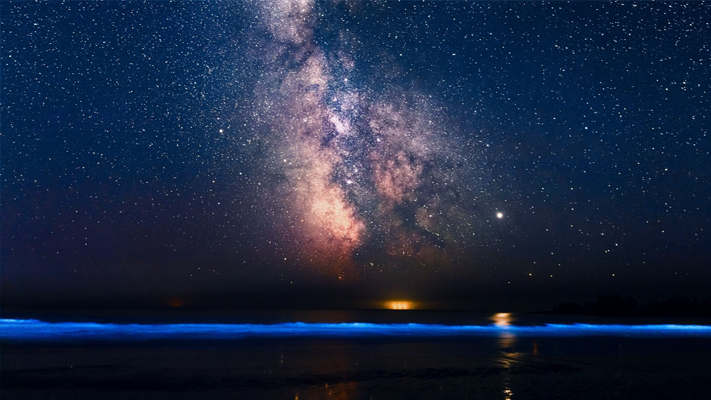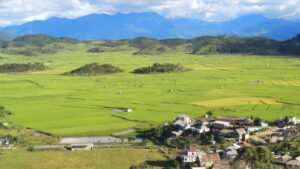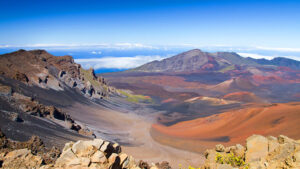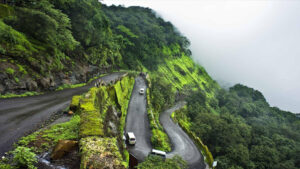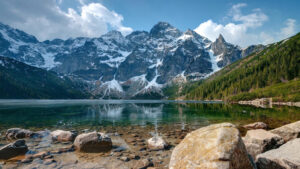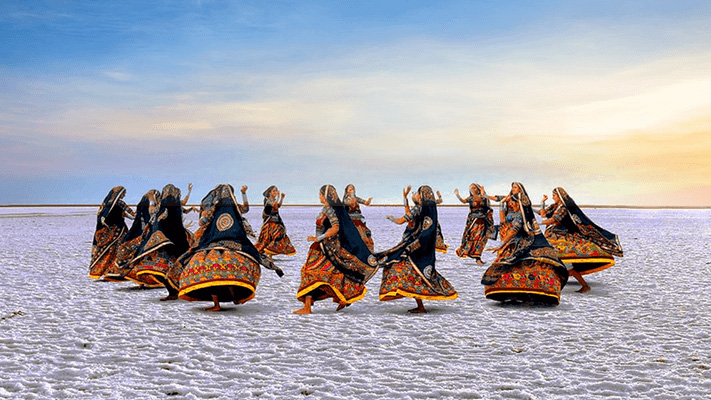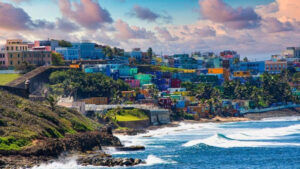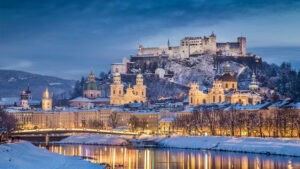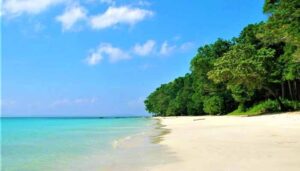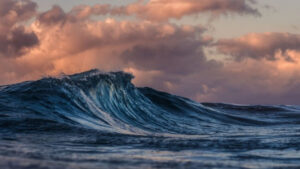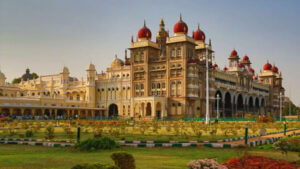SEA OF STARS, VAADHOO ISLAND, MALDIVES – ENCHANTING GLOW OF NATURE’S MAGICAL LIGHT SHOW

The Sea of Stars is a mesmerizing natural phenomenon that occurs in the Vaadhoo Island beach of the Maldives. Also known as the “bioluminescent beach” or “glowing beach,” the Sea of Stars showcases a breathtaking display of shimmering blue lights in the water. The phenomenon is caused by bioluminescent phytoplankton, a type of microorganism that emits light when disturbed. During the night, when the water is calm and dark, the phytoplankton emit a glow that creates a stunning illusion of stars floating in the sea. This enchanting phenomenon is truly a sight to behold, as the beach appears as if it’s covered in thousands of twinkling stars.

Visitors to the Maldives can witness the Sea of Stars by taking a night walk along the beach or embarking on a night-time boat tour. As you stroll along the shoreline, every step creates a magical trail of shimmering blue lights in the water. Watching the waves come alive with bioluminescence is an unforgettable experience that leaves spectators in awe of nature’s wonders.
The Sea of Stars has become a popular tourist attraction, attracting travelers from around the world who are captivated by the ethereal beauty of this natural phenomenon. It is a reminder of the awe-inspiring wonders that exist in our world, where nature’s brilliance takes on extraordinary forms.
What to Expect and Activities Enjoyed
When visiting the Sea of Stars in the Maldives, here’s what you can expect and the activities you can enjoy:
1. Witnessing the Bioluminescence: The main highlight of the Sea of Stars is observing the bioluminescent phytoplankton illuminating the water. As you walk along the beach or take a boat tour, you’ll witness the captivating blue glow, resembling stars twinkling in the sea. The experience is truly magical and unforgettable.
2. Nighttime Beach Stroll: Take a leisurely walk along the beach and immerse yourself in the surreal ambiance created by the glowing water. The illuminated shoreline and waves crashing with a blue glow create a serene and otherworldly atmosphere.
3. Night Diving or Snorkeling: Experience the bioluminescence up close by engaging in a night dive or snorkeling excursion. Plunge into the water and witness the enchanting glow surrounding you as you explore the underwater world. It’s a unique and extraordinary way to interact with the marine life and experience the Sea of Stars from a different perspective.
4. Sunset Cruise: Embark on a sunset cruise, where you can enjoy the breathtaking colors of the sky as the sun sets over the ocean. As darkness falls, witness the transition into the luminous Sea of Stars, making it a truly remarkable and romantic experience.
5. Beach Picnic or Dinner: Enjoy a romantic beach picnic or a candlelit dinner on the shore, accompanied by the ethereal glow of the Sea of Stars. Indulge in delicious Maldivian cuisine while basking in the enchanting atmosphere.
6. Relaxation and Reflection: The Sea of Stars offers a peaceful and serene setting. Sit back, relax, and reflect on the beauty of nature’s wonders. Let the soothing glow of the bioluminescence create a tranquil ambiance that allows you to connect with the natural surroundings.

Interesting Facts
1. Bioluminescent Phytoplankton: The glowing effect in the Sea of Stars is created by bioluminescent phytoplankton called dinoflagellates. These microorganisms emit light when agitated or disturbed, creating the mesmerizing bioluminescent display.
2. Scientific Name: The specific species of dinoflagellates responsible for the bioluminescence in the Maldives is known as Lingulodinium polyedrum. These tiny organisms have a unique ability to produce light through a chemical reaction called bioluminescence.
3. Rare Phenomenon: The Sea of Stars is a relatively rare phenomenon, occurring in only a few places around the world. Other destinations known for bioluminescent beaches include Puerto Rico, the Maldives, and Vaadhoo Island, where the Sea of Stars is located.
4. Seasonal Variation: The intensity of the bioluminescent glow can vary depending on several factors, including water temperature, weather conditions, and the presence of nutrients. The display is typically more prominent during warmer months and in areas with minimal light pollution.
5. Natural Defense Mechanism: The bioluminescent glow of the phytoplankton serves as a defense mechanism against predators. When disturbed, the glowing light acts as a deterrent, confusing potential threats and allowing the phytoplankton to escape.
6. Romantic Association: The ethereal beauty of the Sea of Stars has earned it a reputation as a romantic destination. The sight of the glowing water and the starry ambiance creates a captivating and enchanting atmosphere, making it a popular spot for couples and honeymooners.
7. Conservation and Sustainability: Due to the fragile nature of the marine ecosystem and the importance of preserving the bioluminescent phenomenon, responsible tourism practices and efforts for environmental conservation are being promoted in the Maldives. These initiatives aim to protect the phytoplankton population and maintain the natural beauty of the Sea of Stars.
The Sea of Stars in the Maldives offers a unique and awe-inspiring experience, where nature showcases its incredible wonders.

Top Attractions Nearby
While the Sea of Stars in the Maldives is a captivating natural phenomenon, there are other top attractions to explore in the nearby area. Here are some notable attractions that you can visit:
1. Malé: The capital city of the Maldives, Malé, is a bustling hub that offers a glimpse into the local culture and way of life. Explore the narrow streets, visit the historic Malé Friday Mosque, browse local markets, and immerse yourself in the vibrant atmosphere of the city.
2. Baa Atoll: Located near the Sea of Stars, the Baa Atoll is a UNESCO Biosphere Reserve known for its pristine coral reefs and abundant marine life. Go snorkeling or diving to discover the vibrant underwater world, swim with manta rays, and explore the beautiful islands of the atoll.
3. Ari Atoll: Another popular diving destination, Ari Atoll is renowned for its stunning coral formations, diverse marine species, and excellent dive sites. Explore the underwater beauty, encounter whale sharks and other large pelagic species, and enjoy the tranquility of the pristine beaches.
4. Vaadhoo Island: Since the Sea of Stars is located on Vaadhoo Island, take the opportunity to explore the island itself. Enjoy the pristine beaches, witness traditional Maldivian village life, and indulge in local cuisine.
5. Manta Point: If you’re a fan of manta rays, head to Manta Point, a popular dive site near the Sea of Stars. Here, you have a chance to observe these graceful creatures up close as they glide through the waters.
6. Hanifaru Bay: Hanifaru Bay, situated in the Baa Atoll, is known as a feeding ground for manta rays and whale sharks. If you visit during the right season, you may witness large gatherings of these majestic creatures, creating a truly awe-inspiring sight.
7. Dhigurah Island: Located in the South Ari Atoll, Dhigurah Island offers pristine white-sand beaches, crystal-clear waters, and a relaxed atmosphere. Enjoy snorkeling, diving, or simply unwind on the idyllic beaches.

Best Time to Visit
The best time to visit the Sea of Stars and the Maldives, in general, is during the dry season, which typically runs from November to April. During this period, the weather is generally sunny with little rainfall, providing ideal conditions for outdoor activities and enjoying the beaches.
The months of December to March are particularly popular among tourists, as they offer pleasant temperatures, clear skies, and calm seas. These months are considered the peak season, with higher tourist numbers and prices. If you prefer a quieter and more budget-friendly experience, consider visiting in the shoulder seasons of November and April, as well.
When planning your visit, keep in mind that the Sea of Stars, being a natural phenomenon, can vary in intensity and occurrence. It is advisable to research and consult with local authorities or tour operators for the best times to witness the bioluminescence during your chosen travel period.


